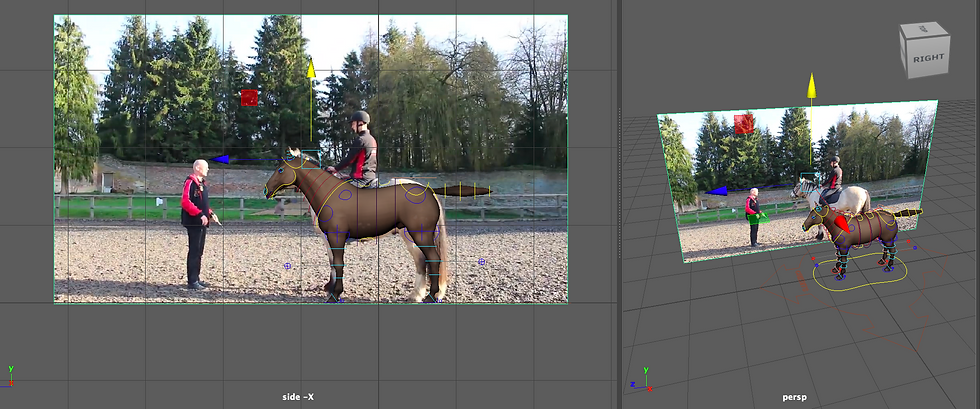Unit 7 : Horse Rearing
- Briony Davies
- Mar 4
- 7 min read
Updated: May 8
In this unit, we are to create an animation based on horse rearing using live-action footage. This method and approach are completely different from the previous work I've been doing. As there are no obvious patterns of movement or a cycle to follow directly, it was a new challenge. I enjoyed exploring this method as it can help enhance and highlight lots of different subtleties and nuances of the body that can go unseen when just following a simple cycle. It can also help add depth, realism, and individualism to the animations and pushes storytelling and creativity by widening my range of approaches and skillset. Additionally, it helps develop a deeper understanding of the character I'm animating, in this case, a horse. I was able to study the weight and flexibility of the animal and really focus on small and specific areas within this short animation. The video I decided to use for referencing was from YouTube called "How to Cope and Deal with Rearing Horses" (Karl Greenwood, 2020), which clearly showcased a horse rearing from a side profile - very important for animating. This video was just to use for this animation, but I wanted to have a clearer understanding of the nuances of a horse. The video also has a rider on and lots of equipment which prevented being able to see the detail. Besides my previous research on horses and their anatomy in articles from The Mane Quest, I wanted to explore horses being used in film, just to get a sense of the type of shots and motions production companies create. In The Black Stallion (1979), it depicts a free-roaming live-action horse and shows them moving naturally, majestically, and more importantly, rearing without the added equipment or extra weight. I used the video from YouTube, as I was unable to find the original film. This really helped make the motion of a horse rearing clear and how the hooves and neck/head react to the impact of the landing. Moreover, I did also review the film SPIRIT: Stallion of the Cimarron (2002) by DreamWorks to show the way horses are animated (even though it is 2D, the principle is the same). I think this helped inspire my work and how to effectively capture a horse rearing, but also it's a good reference that showcases the realistic dynamics and wild essence of a horse.
Key poses from my own animation

I began by downloading the video file and importing it into After Effects to change the frame rate. This was to ensure it plays back at the same rate and speed as Maya. I then imported the video into the scene by the panels tab under image plane. I scaled the image plane to match that of the rig and was fortunate enough that the position of the horse in the video was still and solid, making it easier to start from. I was also fortunate that this video was already stabilized from being filmed on a tripod.

I needed to plan out this animation and really take in what I have learned so far and apply it here. I felt as if I had more of an opportunity to create my own animation here, rather than copy the tutorials. I focused on using my previous knowledge on how to approach this animation. I wanted it to remain clear and organised and follow the principles of animation, as it could be easy to blindly follow the video and not think about the construction of my work. I worked with increments of four frames, which helped break down the positions. It also enabled each control or body part to move simultaneously, thus creating a natural flow of movement. I attentively looked for the extreme positions - the highest and lowest movements of the body. I closely followed the video, making sure each frame matched with the poses, but also taking a step back and making sure it fit well with what I was creating. The images and video here show the positions of the horse, and I feel I have captured it to the best of my skill set.
The horse in the video and the model of the horse have very similar statures, but not the same as they are different breeds, so it wouldn't feel natural to create an exact copy of the horse in the video. The effect the rider has on the horse's back adds additional weight, so again, I did not want to make an exact copy of the horse in the video. This is where further research comes into play. I used the references to help add detail and also to be able to see from a different perspective how the legs, specifically the two front and rear legs, move. It was hard to see this in this specific video as you only have a one-sided perspective. For example, the left front leg rises first, but it was difficult to see how it lands, especially as the horse moves so quickly when landing and also due to the quality of the video.
As always, I used the animation layers to help break down the controls and body parts, which I thought was very helpful and important to do for this method of animation more than before. I wanted to make sure I knew exactly what controls I was using and for what sequence of this animation. There were controls that I hadn't used before when using this rig for the other cycles, such as the leg pole controls. This prevents the front legs from breaking. I also wanted to make sure I had exaggerated poses; for example, the horse really stretches its body from the neck to the hooves when landing, showing a strong line of movement. To create this on the rig, I stretched it slightly beyond what's natural, just to enhance this movement that you see very briefly. Once the base of the animation was created, the next step was to focus on creating that weight of the horse. I used various controls on the legs, shoulders, and hips, as well as the additional controls on the hooves, which "roll" or "bend." This helped show the weight upon impact, as the horse's legs are sturdy but contain a lot of joints that almost "spring" when there is an impactful action, so I created the effect of the weight that distributed to the joints of the ankle/hoof (like the fetlock joint).
I then focused on the fluidity of the movements as there needed to be overlapping action in places such as the head, top of the neck, ears, and tail. I offset the keys but kept them in sync with the video, or as best as I could to avoid stiffness. I enjoyed adding all this detail as I felt my previous animations lacked this, and as I'm now familiar with this rig, I could explore these controls with confidence. I then cleaned up my work in the graph editor and tried to find a pattern of movement and smooth it out so it flowed nicely, as well as creating a constant flow of speed at certain times.

Once the animation was completed to the best of my ability and I felt confident in my creation, I moved on to creating a background set. I knew from the beginning that this horse was going to evoke a sense of freedom, but I really pushed this narrative in my previous horse animations, so I considered doing something slightly different. Since this animation happens on the spot, meaning it doesn't travel in a direction, I didn’t need a large environment. I was inspired by the film SPIRIT to depict the horse's wild nature in a restricted space, capturing its true spirit. I used models from TurboSquid and placed them accordingly, added in planes for the ground and sky, and incorporated a camera and lighting. I can really see how this technique is efficient and beneficial to use in the industry, such as for films and TV, and possibly a cheaper alternative to using motion capture technology for smaller companies, which as a result, creates more complex actions as well as focusing on subtleties realistically.
The Final animation
This is my final animation, and I am pleased with the result. After putting in a considerable amount of time and effort, I feel that this piece represents my strongest work to date. The rig is really well-designed and features intricate and specific controls that allow for a wide range of movements. I also, by now, feel confident in using this rig with being so familiar with it and knowing its strengths and weaknesses, and credit is owed to the rigger. This new method and techniques mixed with everything I have learned so far have enabled me to create animations that are not only realistic but also dynamic, capturing the essence of fluid motion. This approach has opened up new avenues for creativity and expression in my work. I believe that mastering this technique will be incredibly beneficial in the future, allowing me to tackle more complex animations with greater ease. Throughout the process of creating this piece, I dedicated myself to every detail, ensuring that each movement was deliberate and purposeful and has boosted my confidence as an animator. In summary, this final animation is not just showcasing my current skills but also a stepping stone toward future projects. I am excited to see how the lessons learned from this experience will influence my upcoming work and help me continue to grow as an animator.
There is, however, always room for improvement, and based on feedback, I could say I could have chosen a video reference of the horse moving more. For example, when the horse is rearing, the legs are more or less going up and then down, but I could have found a video where the horse remains in the air for some time and kicks its legs out and create a longer animation. This would allow for more appreciation of the motion, making the horse powerful and strong, as it does feel like it lacks some depth.
Refinements and Reflections
Reflecting upon my work, I can say I didn't feel that it was necessary to make any more changes to this specific animation and had positive feedback. I have really enjoyed getting to understand the nuances of horses and their anatomical structure, which has allowed me, at this stage, to produce a confident and detailed animation. I feel I have a deeper understanding as an animator, and I am encouraged to push my abilities to make more creations such as this. I broke down this animation in the video above to focus on my animation abilities alone, rather than looking at the environment set behind, especially as the animation is quick, but still showcasing my creative abilities and knowledge of animation as a whole.















Comments